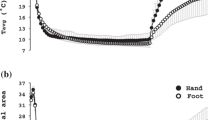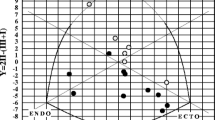Abstract
The relationship between body temperature and the hunting response (intermittent supply of warm blood to cold exposed extremities) was quantified for nine subjects by immersing one hand in 8°C water while their body was either warm, cool or comfortable. Core and skin temperatures were manipulated by exposing the subjects to different ambient temperatures (30, 22, or 15°C), by adjusting their clothing insulation (moderate, light, or none), and by drinking beverages at different temperatures (43, 37 and 0°C). The middle finger temperature (T fi) response was recorded, together with ear canal (T ear), rectal (T re), and mean skin temperature (T¯ sk). The induced mean T ear changes were −0.34 (0.08) and +0.29 (0.03)°C following consumption of the cold and hot beverage, respectively. T¯ sk ranged from 26.7 to 34.5°C during the tests. In the warm environment after a hot drink, the initial finger temperature (T fi,base) was 35.3 (0.4)°C, the minimum finger temperature during immersion (T fi,min) was 11.3 (0.5)°C, and 2.6 (0.4) hunting waves occurred in the 30-min immersion period. In the neutral condition (thermoneutral room and beverage) T fi,base was 32.1 (1.0)°C, T fi,min was 9.6 (0.3)°C, and 1.6 (0.2) waves occurred. In the cold environment after a cold drink, these values were 19.3 (0.9)°C, 8.7 (0.2)°C, and 0.8 (0.2) waves, respectively. A colder body induced a decrease in the magnitude and frequency of the hunting response. The total heat transferred from the hand to the water, as estimated by the area under the middle finger temperature curve, was also dependent upon the induced increase or decrease in T ear and T¯ sk. We conclude that the characteristics of the hunting temperature response curve of the finger are in part determined by core temperature and T¯ sk. Both T fi,min and the maximal finger temperature during immersion were higher when the core temperature was elevated; T¯ sk seemed to be an important determinant of the onset time of the cold-induced vasodilation response.
Similar content being viewed by others
Author information
Authors and Affiliations
Additional information
Accepted: 29 April 1997
Rights and permissions
About this article
Cite this article
Daanen, H., Van de Linde, F., Romet, T. et al. The effect of body temperature on the hunting response of the middle finger skin temperature. Eur J Appl Physiol 76, 538–543 (1997). https://doi.org/10.1007/s004210050287
Issue Date:
DOI: https://doi.org/10.1007/s004210050287




